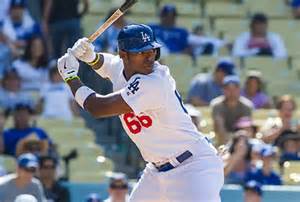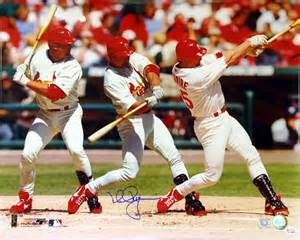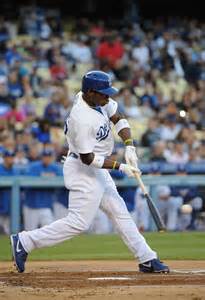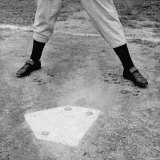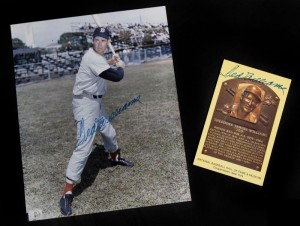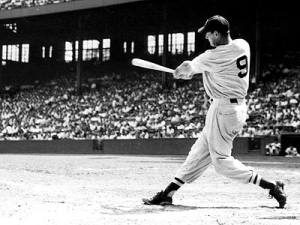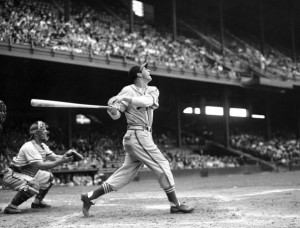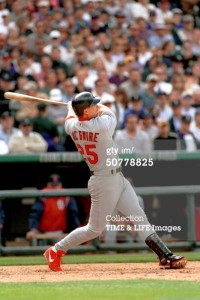Yasiel Puig: Physical Perfection, Yet Batter – Imperfect!
Dodger rookie outfield sensation, Yasiel Puig, is Baseball’s newest physical “Phenom”. But will he be the next legitimate “Super-Star”? Not unless he gains an understanding of the Principle of Hitting that underlies maximum success in a professional ball-player’s quest to be a “Master-Batsman”. Puig possesses all the physical attributes that afford him the greatest accolades from scouts and fans alike. He’s big and strong! He has the highest rated throwing arm, and runs as fast as the fastest in the game. And plays defense as good as the best in professional baseball. He has a good swing, and to the untrained eye looks as if he could be one of the best hitters in baseball. What is it about his batting approach that prevents him from becoming one of the best hitters in baseball, even though he has the “potential” of being the best?
Of the three most illustrious young players in the Major Leagues who are predicted to be Baseball’s next “Super-Stars” (Bryce Harper, Mike Trout, and Yasiel Puig), only Mike Trout’s batting consistency has proven itself worthy of that superlative ranking, so far. Although all 3 embody the physical attributes that warrant the prophetic gesture of Stardom, it is hard to tell “at the moment” who will eventually hold the highest ranking. Trout seems to hold the edge in batting, with a more consistent application of proper mechanics. Both Puig and Harper have better throwing arms than Trout. And Puig and Trout are faster runners than Harper. They all have the statuesque bodies that indicate an innate desire to strive to be the best they can be. But the question to be considered more than any other is, who will best display the mental attitude to foster a determination to reach beyond the merely physical dimension of artistic talent and incorporate the metaphysically scientific dimension that establishes the complete ball-player’s batting prowess?
Most astute baseball observers recognize that “batting a baseball” proficiently can be esteemed as an artistic display of uncommon physical prowess. Those who demonstrate a high degree of talent in any of the various art forms could easily be described as “artists”. There is adequate evidence to indicate that many or most good artists (of which Baseball’s Bats-men are included) have a “natural” propensity toward the artisanship in which they are engaged. But their optimal level of proficiency is most often derived from the degree to which they accumulate enhanced understanding by means of scientific examination of all aspects of their chosen profession. Therefore, hitting a baseball most effectively would have to elicit from the batter’s technique a scientific component to complement his otherwise unfulfilled artistic yet phenomenal talent.
Yasiel Puig falls into that spectacular category of player designated as a “Phenom”. Within that Phenomena Dimension is the manifestation of what appears to be a natural propensity of a physical entity to perform to his/her highest degree of physical competency without the use of supplemental mental facilitation, and indicative of a most primitive, single dimensional, fastball-hitting mentality. “Power versus Power,” exhibits in a batter a need to gain a forward momentum in order to counteract the otherwise debilitating effect of a pitcher’s blazing fastball. Adapting to “off-speed” pitches entails a dimension of thought that includes a scientific component. A batter, incapable of adapting to any such circumstance, becomes easy prey to the pitcher who can throw a curveball for a strike. Thus, the sudden or gradual decline in promise of the physical “phenom”!
The scientific approach that Ted Williams brought to “Hitting” certainly superseded the “no-brainer” application that the “natural-artisans” expressed through their mere adherence to sense testimony. Such scientific revelation should have continued to override the equally reprehensible technique endorsed by those pseudo-scientific proponents of the “downward swing”, which followed. Any batter whose notion of proper hitting technique includes the idea that a downward swinging bat can effectively strike a downward moving ball with the least margin of error does not understand the statistical improbability of such folly.
By knowing that a pitched ball is always traveling downward into the strike-zone, the intelligent batter will devise a technique that will ensure that the bat will strike the ball on a line as close to 180 degrees as is possible. To be 100% accurate with his guidance of the bat-to-ball is most improbable. But if the swinging bat is on the same parallel line as the in-coming ball, then the probability of solid contact will be strong, and the result most often will be a desirable ascending “line-drive.”
The “Ultimate Batting Principle” is based on the perfect application and integration of following components:
1. Balance and stability of the stance.
2. Security for undisturbed visual acuity.
3. Self-contained power source.
4. Balance and stability from start to finish of swing.
A low center of gravity can be established by spreading the feet to the length of one’s normal stride, and bending the knees as low as can accommodate comfort and quickness. This strong base affords the batter the fastest possible reaction time for a twisting body to respond to any variation of pitched balls. One of the most prominent features of a low stance is the obvious advantage the batter has with the establishment of a smaller strike zone.
With the low-wide stance, the batter is in an “ultra-stationary” position, from which to view the pitched ball with a minimum of distortion. As a tennis player, receiving serve, is bent over and down as low as he can, to see the speeding ball on as close to a parallel level to the eyes as possible, so the batter, in a low stance, views the pitched ball with most clarity.
With the body already in a stable and powerful position, from which to initiate the action of the swing, the only preliminary movement needed by the batter, as the pitcher is delivering the ball, is to brace himself (or “gather”). From there he awaits the arrival of the ball into the striking “zone.” The gathering simply implies that the body is twisting or coiling slightly in the direction toward the catcher, bringing the hands to a position just beyond the back shoulder, making ready to spring forward as the ball comes to the plate. The “coiling” is initiated by the front knee turning inwardly off a pivoting big toe whose foot is point at a 45 degree angle to the pitcher. While the back foot is anchored flat, the weight of the body is centered from the upper abdomen to the ground directly between both knees. The hips and shoulders follow the backward rotation of the twisting torso (the body never leaning backward with any concentration of weight on the back leg-the “buttocks” looks to be sitting on a high stool). The entire action of the backward twisting and subsequent forward explosion (without a stride) in the opposite direction, as the swing takes place (after the front foot plants firmly into the ground), occurs while the head remains stationary and the eyes still, focusing on the ball.
The first metaphysical component to the perfect swing of a baseball bat is the ability to inhibit one’s personal proclivity to attack the oncoming pitched ball with direct linear force. The psychological tendency to meet an attacker head-on, with equal force, in order to counteract an over-powering momentum, most often imposes an obliteration effect that can prove unproductive in either direction.
The batter, when encountering the power of a 90 to 100 mph fastball, does not want to be intimidated by what could be an overwhelming force of speed. So he seems magnetically drawn in the direction from which the ball is coming, to offset somewhat the intent of the oncoming projectile. Figuratively, attacking the ball is attacking the opponent (pitcher) who threw it. The linear movement in the direction from which the ball is coming can give only an illusory sense of contrived confidence and facilitation to deploy a resourceful counterattack. Since the first incidence of an actual counterattack cannot proceed until the front foot plants itself to the ground, the airborne foot only creates a factor of vulnerability to the batter whose visual acuity is already substantially distorted by any movement of the head and eyes that automatically occurs as the body lunges forward.
Great athletes seem to have the ability to make certain physical adaptations that allow them to counteract visual distortions, some of the time, to maintain a respectable productivity. But, if all hitters would recognize that they are not sacrificing power with eliminating the “stride” and keeping the head still, their current batting performances would improve. The “ultimate-hitting” Principle can now assert a more pronounced effectiveness against the statistical dominance of the “Premier Pitcher Principle”– (which is merely an illusion). The missing link in applying the hitting principle has always been the inconsistent visual acuity of the batter in accurately detecting the speed of the fast-ball, as well as the direction and varying speeds of “breaking” and other off-speed pitches. All this, of course, was due to excessive movement of the head, the primary culprits being the tall stance, high bat, and batter’s stride. Although the pitcher’s arsenal of distracting and illusory forces will still wreak their havoc on unsuspecting “head-gliders,” a new era of batting prominence will set the standard for hitting elegance.
Puig’s primary margins for error are his high stance, his stride, and the side-ways position of his front foot. If he croutched down, with feet spread to the length of his normal stride, and pointed his front foot at a 45 degree angle to the pitcher, and took no stride, then he would be able to have maximum balance (at the beginning and end of swing), see the ball most clearly, and wait longer before exploding onto the pitched ball.
Thus the process is simple and the results are sure if the Science is understood.
